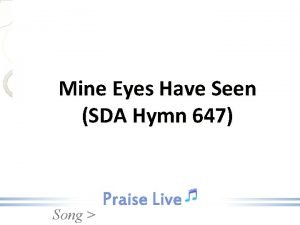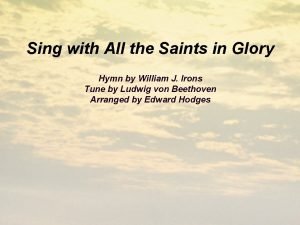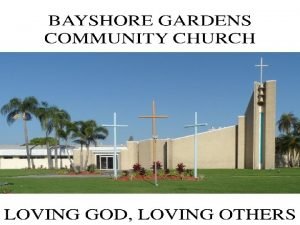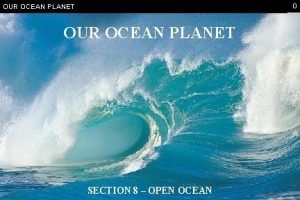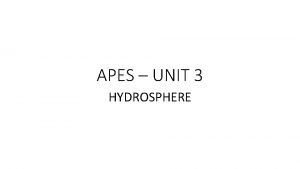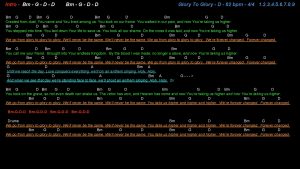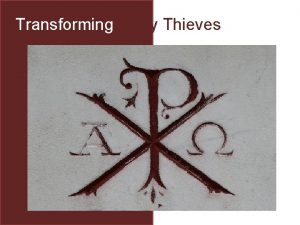THE OCEAN AND ALL OF ITS GLORY FACTS





































- Slides: 37

THE OCEAN AND ALL OF ITS GLORY

FACTS • • 95% is unexplored Full of life and resources Saltwater – 3. 5% salt Holds a lot of heat – Causes weather and climate • Carbon Dioxide is the most abundant gas – Needed for photosynthesis – leads to oxygen production – Reacts with water to form BICARBONATES – needed by animals to make hard shells.

LIFE • Marine organisms are classified on where they live and how they move. – Plankton – FLOATERS. Move with waves and currents. Ex algea – Nekton –FREE SWIMMERS. Go where they want. Ex fish, sharks, whales – Benthos –BOTTOM DWELLERS. BENTHIC ZONE. Ex. octopus, starfish, sponges

FEATURES OF THE OCEAN • Ocean floor is full of features. – Shallow Water • Continental shelf – gently sloping area of ocean floor, extends outward from a continent. • Continental slope – edge of a continent

FEATURES CONT. • Open Ocean – Seamounts – underwater mountains, below the surface – Abyssal plain – smooth nearly flat region – Oceanic ridge – continuous mountain range, winds around earth. – 80, 000 KM long, longest mountain range on earth

FEATURES CONT. • Deepest Depths – Trench - canyon in the ocean floor – Deepest places on earth – MARIANA TRENCH – deepest point, 11 KM down Explored by the crew of the TRIESTE

FEATURES

OCEAN ZONES

Ocean Zones • Inter-tidal zone – highest high tide line to the lowest low tide line.

Intertidal Zone • Organisms that live in the intertidal zone must be able to: • • Tolerate pounding of waves Change in salinity and temperature Periods of being underwater or exposed to air EX. Rocky shores and tide pools

NERITIC ZONE • Neritic zone – from low tide line to continental shelf.

NERITIC ZONE • Neritic Zone – Huge variety of organisms – Major fishing grounds – Over continental shelf – Receives sun-light and steady supply of nutrients. • Part of the PHOTIC ZONE – part of the ocean that receives sun light, surface to 1 km

Neritic Zone • Site of many UPWELLING currents – bring nutrients up from the deep ocean • This is where you find a lot of life because of food. • Support large number of phytoplankton – base of ocean food web – Perform photosynthesis, produce large amounts of oxygen

NERITIC ZONE • Coral Reefs – Warm tropical, SUNNY areas – Made of limestone deposits from Coral • Tiny animals that need algae to live – Provide habitat for other creatures • Huge diversity of life – Endangered due to pollution • Algae then coral die (bleached)


NERITIC ZONE • KELP FOREST – Cold water – Need a lot of SUN LIGHT – Can grow 40 m tall – Provide habitat


OPEN OCEAN • Begins at the edge of continental shelf – Only small parts receives sunlight – surface zone – Fewer nutrients -- not as much life

OPEN OCEAN • Open-ocean zone – beyond the edge of the continental shelf.

OPEN OCEAN • DEEP ZONE – Few organisms – many of these produce their own light – BIOLUMINESCENCE – production of light by living things – Chemical reaction in cells – Animal in this zone are good hunters – have to be to survive – Most are EXTREMOPHILES – organism that survives in harsh conditions


OPEN OCEAN • HYDROTHERMAL VENTS – where hot water rises out of cracks in the ocean floor – Water is heated by magma – Hot water carries gasses and minerals – Some bacteria feed on these minerals and use them to produce food – • CHEMOSYNTHESIS – using chemicals to produce food.


• GIANT TUBE WORMS – CAN GROW TO BE 8 FEET, DEPEND ON BACTERIA THAT LIVE INSIDE OF THEM TO PRODUCE FOOD. THEY HAVE NO MOUTH OR DIGESTIVE TRACT.

OCEAN RELATIONSHIPS • Producers – photosynthetic organisms. Produce their own food -- algae (phytoplankton) • Consumers –eat other organisms • Decomposers – breakdown waste or dead organisms

OCEAN RELATIONSIPS • FOOD WEBS – intricate feeding relationships among producers, consumers and decomposers • Terrestrial food web – refers to land – Aquatic food web – refers to water • these always intertwine • Food Chain – a specific series of feeding relationships.

OCEAN RELATIONSHIPS • Basis of most ocean food webs are photosynthetic • organisms (phytoplankton) – Exception – bacteria at the vents – they are chemosynthetic • Problems if they die


OCEAN RESOURCES • LIVING • Fishes and other organisms • Food • Detergents, cosmetics, ice cream, tooth paste and paints » EX. Algae (gelatin-like) and Diatoms • If over fished, these will go away. We must manage wisely.

OCEAN RESOURCES • NON LIVING • Minerals – Salt from ocean is valuable – Magnesium – Gravel and Sand for building – Diamonds and Gold • Fuels – Oil and Natural Gas (continental shelf), economically beneficial • Water – Desalination provides water to dry regions. • Travel and shipping

OCEAN POLLUTION • Most pollution comes from the land. – NATURAL – heavy rains wash freshwater into an estuary. – HUMAN ACTIVITY – Sewage, chemicals, trash, runoff and oil. – The ocean can self clean however, to much pollution is deadly.

EXPLORING THE OCEAN • People have studied the ocean since ancient times. • Source of food • Route for trade and travel Modern Scientist have studied the characteristics of the ocean water and floor. OCEANOGRAPHER

• The H. M. S. Challenger embarked from Portsmouth, England on December 21, 1872 and changed the course of scientific history. Physicists, chemists, and biologists collaborated with expert navigators to map the sea. This interdisciplinary spirit has continued to the present day. During the 4 year journey, the voyages circumnavigated the globe, sounded the ocean bottom to a depth of 26, 850 feet, found many new species, and provided collections for scores of biologists.

EXPLORING THE OCEAN FLOOR • Last frontier – cold, dark, harsh conditions with, very high water pressure. Humans cannot survive. Led to the development of technology to explore the ocean floor. 1925 – Major advance SONAR – SOund NAvigation and Ranging

SONAR • Uses sound waves to calculate the distance to an object. - pulse of sound is sent out - bounces off ocean floor - equipment measures how quickly the sound returns

• Sound waves are sent down. The time it takes for them to return is recorded and a depth is determined.

OTHER ADVANCES • 1943 – Self Contained Underwater Breathing Apparatus • 1960 – Submersibles – TRIESTE • 1978 – Satellites • 1986 – Remote underwater manipulator • 2003 – Deep flight navigator
 榮耀神羔羊
榮耀神羔羊 All god's children singing glory glory
All god's children singing glory glory Glory glory hallelujah sda hymnal
Glory glory hallelujah sda hymnal Holy holy holy lord god almighty
Holy holy holy lord god almighty Glory glory how the angels sing
Glory glory how the angels sing Nekton include all animals that
Nekton include all animals that Convergent boundaries features
Convergent boundaries features Ocean ocean convergent boundary
Ocean ocean convergent boundary Convergent plate boundaries
Convergent plate boundaries Ocean ocean convergent boundary
Ocean ocean convergent boundary Scrat s continental crack up
Scrat s continental crack up Ocean to ocean convergent boundary
Ocean to ocean convergent boundary Red ocean strategi
Red ocean strategi The yellow terror in all his glory
The yellow terror in all his glory Sing with all the saints in glory hymn
Sing with all the saints in glory hymn All glory
All glory All glory to god
All glory to god All glory to him
All glory to him It's the song of the redeemed
It's the song of the redeemed Name a point that is collinear with the given points
Name a point that is collinear with the given points Interesting facts about the open ocean
Interesting facts about the open ocean Mississippi river
Mississippi river Pacific ocean facts
Pacific ocean facts Multiplication facts and division facts
Multiplication facts and division facts Emigree poem
Emigree poem Its halloween its halloween the moon is full and bright
Its halloween its halloween the moon is full and bright Blessing and honor glory and power
Blessing and honor glory and power These beauteous forms
These beauteous forms When a train increases its velocity its momentum
When a train increases its velocity its momentum Weather sunny cloudy rainy windy
Weather sunny cloudy rainy windy If its a square it's a sonnet summary
If its a square it's a sonnet summary Its not easy but its worth it
Its not easy but its worth it Hát kết hợp bộ gõ cơ thể
Hát kết hợp bộ gõ cơ thể Frameset trong html5
Frameset trong html5 Bổ thể
Bổ thể Tỉ lệ cơ thể trẻ em
Tỉ lệ cơ thể trẻ em Chó sói
Chó sói Tư thế worm breton
Tư thế worm breton


